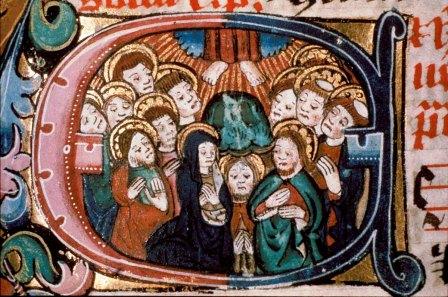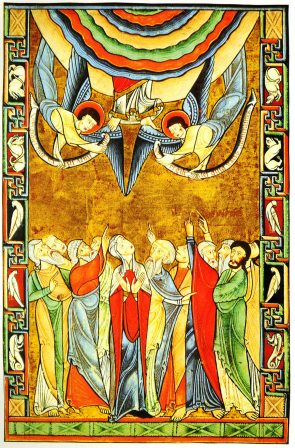There are many images of the Lord’s Ascension to heaven.
The one’s I like the most are the medieval depictions which show the Apostles and Mary looking up and all you see above are a pair of lordly Feet.

There is a good reflection at the site Ignatius Insight, which provides an excerpt from “The Ascension: The Beginning of a New Nearness,” from Joseph Ratzinger’s Images of Hope: Meditations on Major Feasts (Ignatius Press, 2006). My emphases and comments:
You are surely familiar with all those precious, naïve images in which only the feet of Jesus are visible, sticking out of the cloud, at the heads of the apostles. The cloud, for its part, is a dark circle on the perimeter; on the inside, however, blazing light. It occurs to me that precisely in the apparent naïveté of this representation something very deep comes into view. All we see of Christ in the time of history are his feet and the cloud. His feet—what are they?
We are reminded, first of all, of a peculiar sentence from the Resurrection account in Matthew’s Gospel, where it is said that the women held onto the feet of the Risen Lord and worshipped him. As the Risen One, he towers over earthly proportions. We can still only touch his feet; and we touch them in adoration. Here we could reflect that we come as worshippers, following his trail, close to his footsteps. Praying, we go to him; praying, we touch him, even if in this world, so to speak, always only from below, only from afar, always only on the trail of his earthly steps. At the same time it becomes clear that we do not find the footprints of Christ when we look only below, when we measure only footprints and want to subsume faith in the obvious. The Lord is movement toward above, and only in moving ourselves, in looking up and ascending, do we recognize him.
When we read the Church Fathers something important is added. The correct ascent of man occurs precisely where he learns, in humbly turning toward his neighbor, to bow very deeply, down to his feet, down to the gesture of the washing of feet. It is precisely humility, which can bow low, that carries man upward. This is the dynamic of ascent that the feast of the Ascension wants to teach us.



































We had Ascension Thursday Thursday in Portland today! A peaceful Dominican Rite low Mass. Thank you, prior.
Rather Octave-mindedly, I’m just catching up: thank you for this!
The visual image that come to my mind is in stained glass – seraphically red Footsoles (but I don’t know where I know it from: is it a traditional image?). (A contrast, it now strikes me, with the Footsoles in perspective paintings of Our Lord reposing Bodily in death – which I suppose must only be late – Renaissance and after – though I am not sure how it relates to Epitaphion images and such like, and perhaps to sculptures.)
Liturgical and devotional ‘vestigia’ imagery is something else I would like to know more about. Can you, or can anyone, recommend any online resources? (I suspect many English speakers will, like me, have first met it imaginatively distilled in reference to Good King St. Wenceslas by J.M. Neale – “Mark my footsteps…”: the saint following in the vestigia of Our Lord producing beneficially followable footsteps in his turn.)